A machine maintenance checklist is a document for ensuring equipment operates efficiently and avoids unexpected breakdowns. It provides a systematic approach to inspect, service, and maintain machines regularly. By…
continue reading
50+ SAMPLE Equipment Checklist
-
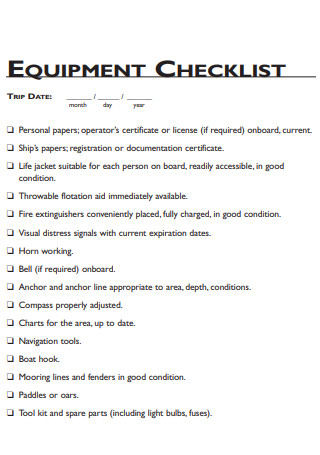
Equipment Checklist
download now -

Weekly Equipment Checklist
download now -

Pre-Use Equipment Inspection
download now -

Personal Protective Equipment Checklist
download now -

Boater & Boat Equipment Checklist
download now -

Equipment Maintenance Checklist
download now -

Equipment Daily Checklist
download now -

Vehicle Equipment Pre Use Inspection Checklist
download now -

Earth Moving Equipment Checklist
download now -

Fixed Equipment Checklist
download now -
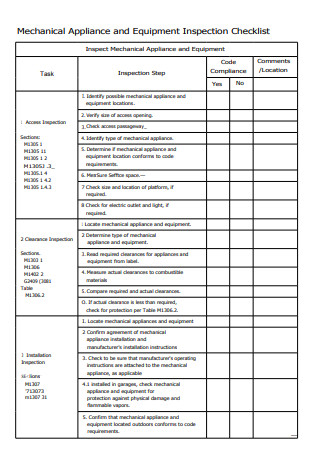
Mechanical Appliance and Equipment Inspection Checklist
download now -

Heavy Equipment Inspection Checklist
download now -

Required Equipment Checklist
download now -

Equipment and Inventory Review Checklist
download now -

Quarterly Equipment Inspection Checklist
download now -

Personal Equipment Checklist
download now -

Technology Equipment Checklist
download now -

Mobile Equipment Checklist
download now -

Equipment and Machine Safety Checklist
download now -

General Equipment Checklist
download now -

Individual Equipment Checklist
download now -

Geology Equipment Checklist
download now -
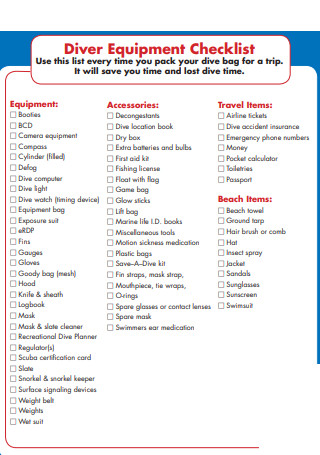
Diver Equipment Checklist
download now -

Shop Equipment Checklist
download now -

Equipment Training Checklist
download now -

Residential Service Equipment Checklist
download now -
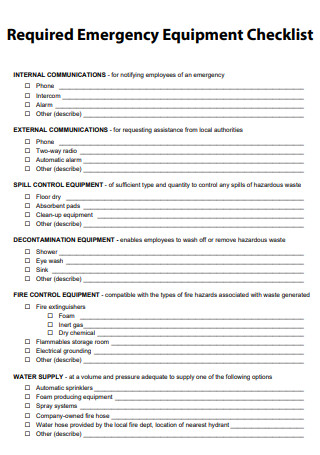
Required Emergency Equipment Checklist
download now -

IT Equipment Checklist
download now -
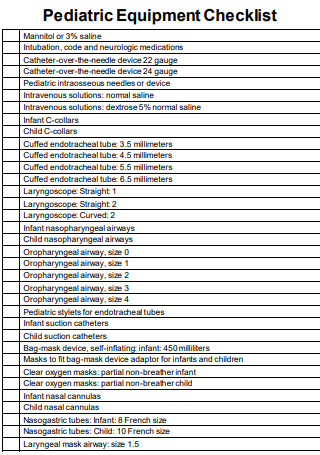
Pediatric Equipment Checklist
download now -

Respiratory Equipment Inspection Checklist
download now -

Temporary Equipment Checklist
download now -

New Equipment Checklist
download now -

Refrigerated Equipment Checklist
download now -

Personal Camping Equipment Checklist
download now -

Tagout Equipment Checklist
download now -

Equipment Payment Checklist
download now -

Equipment Compatibility Checklist
download now -

Equipment Process Validation Checklist
download now -

Machinery and Equipment Checklist
download now -

Fall Protection Equipment Checklist
download now -

Referee Equipment Checklist
download now -

Building Systems and Equipment Checklist
download now -

Unit Equipment Checklist
download now -

String Instrument and Equipment Checklist
download now -

Sample Equipment Checklist
download now -

Equipment Checklist and Purchasing Tips
download now -
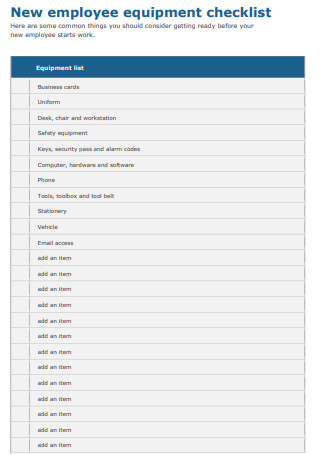
New Employee Equipment Checklist
download now -

Demo Equipment Checklist
download now -

Gym Equipment Checklist
download now -

Standard Equipment Checklist
download now -

Equipment Lease Checklist
download now
What Is an Equipment?
Equipment is most frequently referred to as a collection of tools or other objects often utilized to accomplish a specific task. Various jobs necessitate the use of a variety of different pieces of equipment. According to statistics, capital expenditures on structures and equipment grew 6.4% in 2019 for businesses with employees.
Benefits of an Equipment Inspection
We’ve discovered that enterprises that do routine equipment inspections are often more profitable than those that do not. Nonetheless, the notion persists that equipment inspections are solely concerned with compliance. Inspections of equipment save money. This obsession with conformity is understandable. Companies may be compelled to examine special equipment on a prescribed timetable depending on their location and business. After you are forced to do anything, it is natural to believe that you have completed what you were required to do when you meet the requirement. However, consider the most successful businesses. You’ll see that they inspect more frequently than needed and inspect equipment that is not even covered by regulations. Their view of inspections as a critical business activity demonstrates that they recognize the benefits of equipment inspections beyond compliance. They are aware from experience that when inspections are conducted thoroughly, and the results are acted upon effectively, expenses are lowered, and productivity increases. If you’re still intrigued, here are a few of the advantages.
Tips To Maintain Equipment’s Life
Heavy machinery, particularly mining, industrial, and agricultural equipment, requires continuous maintenance to remain in excellent operating order. On the other hand, poorly maintained heavy mechanical equipment is inefficient. Breakdowns are expensive, and safety is also a concern. The following are five essential principles for maintaining heavy machinery:
-
1. Maintain current knowledge of ample machinery operator training.
There are several operators on many sorts of heavy machinery. Overseeing the proper operation of the equipment should be one of the ongoing inspections on any checklist. Large machinery should be thoroughly inspected before being purchased. Operator training is usually completed at this time. However, it is necessary to continue training. Employees come and go, skills rust and inefficient operations result in breakdowns. Operator manuals can be tailored to the exact needs of the job, and they can be rewritten more straightforwardly. Each operator might receive a short manual for quick reference. And, if you work in a paperless office, you can be sure that your employees are using the most recent version of each manual. Another point to consider is identifying best practices that can subsequently be implemented in other facilities or locations. The knowledge you gain about maintaining your equipment can be beneficial, so make the most of it and apply it to any situation that applies.
2. Lubricants should be added and tested regularly.
Lubricants are used to reduce friction in the vicinity of any moving part. A regular maintenance schedule for proper lubrication enhances the life of heavy industrial equipment and parts. Lubrication is one of the most basic and critical maintenance checks. Examine the pistons for evidence of excessive oil or grease buildup. Examine the area surrounding the oil seals for leakage. Ascertain that you are using the proper lubricant. Each component requires a unique type of oil or grease. Consult the manufacturer’s instructions. Lubricant inspections are an excellent technique to discover problems with heavy machinery. Experts analyze particles in used oil. Contaminants’ chemical composition will reveal which component is experiencing wear or disintegration.
3. Maintain Their Sharpness
If your machine tool features components for cutting, slicing, or sharpening, you must inspect it for sharpness regularly. Wear and tear on these sharpening parts can not only make your machine work harder, generating extra wear and tear, but it can also jeopardize output by resulting in inferior products. This is especially true if the materials you’re making are precision-engineered and require extreme precision.
4. Keep heavy machinery clean and the surrounding area clean.
Numerous seals and filters are installed on large machinery to keep working parts clean and contamination-free. Seals should be inspected often to ensure they remain healthy. Filters should be inspected and replaced on a routine basis. Breathers should be kept clean to avoid producing a vacuum in the cab, sucking contaminants in. Contaminated electronics in the cab are prone to failure. This affects the clutch, for instance. Large machinery should be stored in a shed or other structure if possible. Wind and weather exposure can cause rust and decay. If the machinery is not in use, it should be run regularly.
5. Accessories Are Not To Be Ignored
While maintaining the machine is critical for its health, it’s also crucial to apply these same standards of care to accessories. Accessories for appliances should be treated and stored similarly, and you should always take care to purchase suitable accessories for your equipment and its requirements. Incompatible attachments can cost you time and money, mainly if they result in faulty machines down the road.
How To Keep Equipments Safe at Work
Significant investments in equipment and tools are made as manufacturing, assembly, refining, or extraction firm. Though most of these investments are one-time and require little upkeep, this equipment can be pretty costly. Additionally, any accidents involving these devices would result in financial loss and constitute a significant threat to the operators. It is critical that work equipment is safe and that employees who directly contact the machine receive sufficient training. Things become even more essential if you are in a mining or extraction company. Additionally, additional instances of machinery failure may result in unfortunate incidents. Here’s how you can guarantee the safety of your working equipment and mining safety:
-
1. Manage Your Investments Carefully
Machines are a one-time investment; nevertheless, due to limited cash, firms frequently overlook the quality of the machines while investing. This can lead the machinery to malfunction and create accidents, putting a lot of lives and money at risk. Thus, it is always prudent to conduct an extensive study and look for a more realistic approach that may be less expensive than purchasing malfunctioning or low-quality technology. In the mining sector, tunneling deep beneath the earth’s surface or through mountainsides requires complex materials that are precise and easy to utilize. Not only would imprecision or a lack of quality result in damage, but it would also result in delays and losses, which would be detrimental to a firm.
2. Trained Professionals
Handling large machinery is not for everyone. Years of rigorous training and experience are required to become an expert in the management of such equipment. Along with machinery, it is critical to invest in highly qualified individuals. This is because if an employee is not adequately trained to operate a piece of equipment, they risk causing an accident or causing harm to the business and its property. Additionally, they would cause delays, resulting in losses. However, that is not the case; an inexperienced professional would endanger your business’s most valuable asset: the machinery itself. They would threaten their coworkers and risk causing catastrophic damage. Hiring operators for such equipment is almost as challenging as investing in the equipment itself. It is critical to have someone with substantial knowledge and certifications run the equipment.
3. Periodical Maintenance
Nothing is more complicated in this world than devices that aren’t serviced and maintained regularly. Equipment and machines must be maintained periodically, and they must be cleaned and oiled. Damaged components must either be repaired or removed and replaced. When a corporation puts off equipment maintenance, especially when needed, they expose their employees and the machinery to the danger of accidents and malfunction. With continual digging and extraction processes, the equipment underneath is exposed to extreme circumstances, especially mining. They also need to be held regularly to function effectively. If you neglect equipment maintenance to save money, you’re doing yourself a disservice. Failure to maintain would result in unfortunate circumstances that could cost you far more than regular maintenance. Working with heavy machinery is the most excellent method to ensure easier operations and a risk-free work environment.
4. Improve Your Employee’s Skills
While you may have recruited skilled operators and experienced, no amount of training is ever sufficient. It is also vital to urge your employees to take OSHA training programs regularly to stay current on newer methods of increasing machine efficiency, ensuring that the equipment is safe to handle and properly maintain. Regular training teaches employees how to handle their equipment safely and efficiently, protecting their coworkers and minimizing workplace hazards. Managing equipment for your firm, especially mining, is a difficult task. Your working equipment should be safe to avoid tragic situations and significant losses.
FAQs
What is the definition of a checklist format?
A checklist is a document used to keep track of objects or actions required in the workplace. It is utilized in the workplace scheduling process to ensure that the workplace runs smoothly.
What is the definition of a basic checklist?
A simple checklist template is any method or list of activities organized in the form of a checklist; in other words, it’s a to-do list where task order is usually significant.
What purpose does a checklist serve?
Checklists supply detail for each step of a process, allowing you to stay organized. It can be used as a visual reminder, a method of prioritizing daily tasks, and a means to schedule all that has to be done to avoid missing deadlines. It’s simple to use, and it’s highly effective at making sure you finish all of the stages.
If you believe you are prepared to design an equipment checklist, ensure that you know the factors to consider while creating this tool. Additionally, you must remember that all stakeholders engaged in the operation, maintenance, and storage of equipment should be included while establishing an equipment checklist. Always direct to the downloadable samples in this post to verify that your equipment checklist design is well-guided. Whether you create a task checklist or a bare equipment record for updating, don’t forget to create an effective tool that will assist the entities responsible for equipment listing and maintenance in doing their tasks more efficiently and effectively.


